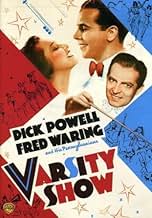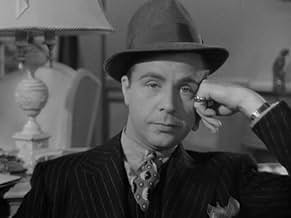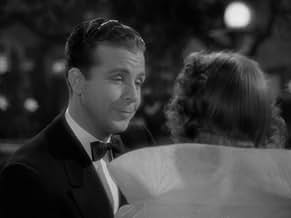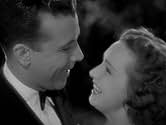VALUTAZIONE IMDb
6,1/10
520
LA TUA VALUTAZIONE
Aggiungi una trama nella tua linguaA former student who is now a big Broadway show producer with three flops to his reputation, is invited back to direct the College's annual student stage show.A former student who is now a big Broadway show producer with three flops to his reputation, is invited back to direct the College's annual student stage show.A former student who is now a big Broadway show producer with three flops to his reputation, is invited back to direct the College's annual student stage show.
- Regia
- Sceneggiatura
- Star
- Candidato a 1 Oscar
- 1 vittoria e 1 candidatura in totale
Johnnie Davis
- Buzz Bolton
- (as Johnny Davis)
Ford Washington Lee
- Buck
- (as Buck)
John W. Bubbles
- Bubbles
- (as Bubbles)
Recensioni in evidenza
Why watch Varsity Show? Two words: John Bubbles, the man Fred Astaire said was the greatest tap dancer of his generation. John Sublette (John Bubbles was his stage name) and his partner, Ford Washington Lee, were Buck and Bubbles, with Buck primarily at the piano and Bubbles dancing and singing. They were major stars in vaudeville. I can't explain dancing any more than an infant can explain milk, but I know the good stuff when I see it. John Bubbles combined tap, a sort of fast shuffle and ingenious rhythm into something I wouldn't argue with Astaire about. He has a couple of short numbers in this inane college musical and one Buck and Bubbles short production number to "Have You Got Any Castles, Baby?" They make watching the movie something special.
Among the aged aspects of Varsity Show that you have to get past to enjoy the tap artistry of John Bubbles are...the jokes are so corny even Iowa wouldn't take credit for them...the pacing is just about as matter-of-fact as that bland title...several of the students have long since past their college years...ironically, Dick Powell seems too young for the part...and Fred Waring as the drama teacher is so sincere, so constantly smiling and so solicitous of the students as to be creepy.
Still, the Richard Whiting and Johnny Mercer songs aren't bad. "We're working Our Way Through College," sung by Powell and the students as they stride through the campus, is bouncy and funny.
"We're working our way through college / To get a lot of knowledge / That we'll probably never ever use again.
It's swell to tell what parallel and parallax is, / But after graduation will it pay our taxes?"
For those fond of choral music there's Waring and his Pennsylvanians (they're in the movie as college students) doing some fine singing. Aficionados of college pep songs will hear a bunch of them at the big smash close. And for those with a morbid fondness for stories about alcoholics, there's Ted Healy in a major role and Lee Dixon in a minor one. Healy, who's the reason there was a Three Stooges, wound up in Hollywood as one of the highest paid comedy actors. His specialty was the big grump. Let me tell you, he was good. He also was a big-time alcoholic. He got into a drunken fight the night his first child was born (the year Varsity Show was released) and died several hours later. He was 41. Lee Dixon was big and blond, an eccentric dancer in the early Buddy Ebsen style. He was handsome enough with an open, quizzical kind of face. He towered over everyone else. He was 23 when he made Varsity Show and played one of the students, had a few lines and a couple of brief dance steps. By the early Forties he was drinking so heavily no one wanted to take a chance on him. Rodgers and Hammerstein offered him the part of Will Smith in Oklahoma! after extracting the promise he wouldn't hit the bottle. He received great reviews with his two numbers, "Kansas City" and "All Er Nuthin'" (with Celeste Holm as Ado Annie). All was well for a year or so, then he started sneaking drinks, then more and more. That was that. He faded fast and died at 39 in 1954. What's the moral to Healy and Dixon? You've got me.
The story? The kids at Winfield College are putting on the annual varsity show but their professor adviser insists that there'll be nothing "swinging" or "modern." A group of them decide to go to New York and ask Chuck Daly (Dick Powell), famous Broadway producer and Winfield graduate, to take over the show. They've got a lot of great songs and ideas. They don't know that Daly has had three flops in a row and is broke. We can skip the next hour. The show is a smash, on Broadway no less, with a Busby Berkeley finale. Chuck wins a co- ed's love with Rosemary Lane the co-ed. She's second billed after Powell. Her sister, Priscilla, is third billed and gets a song to sing and a few dance steps to share with Dixon. Priscilla Lane has never done much for me, but here, at 22 and in her first movie, she's a cutie pie.
College musicals always seem to give off that indulgent condescension that so many adults reserve, usually to their regret, for the young. Still, some can be a lot of fun. There are three I like a lot. Too Many Girls has a book as inane as Varsity Show, but it has a great Rodgers and Hart score and a terrific Lucille Ball performance. Best Foot Forward has a fine Hugh Martin and Ralph Blane score, including that rouser, "Buckle Down, Winsocki," plus Ball again, and a great cast that includes June Allyson and Nancy Walker. Good News is a lot of fun, just as corny as the rest, but June Allyson is appealing, Peter Lawford avoids being appalling, and best of all there's Joan McCracken and Ray McDonald dancing. "Pass that Peace Pipe" is a showcase for both of them, especially McCracken.
Among the aged aspects of Varsity Show that you have to get past to enjoy the tap artistry of John Bubbles are...the jokes are so corny even Iowa wouldn't take credit for them...the pacing is just about as matter-of-fact as that bland title...several of the students have long since past their college years...ironically, Dick Powell seems too young for the part...and Fred Waring as the drama teacher is so sincere, so constantly smiling and so solicitous of the students as to be creepy.
Still, the Richard Whiting and Johnny Mercer songs aren't bad. "We're working Our Way Through College," sung by Powell and the students as they stride through the campus, is bouncy and funny.
"We're working our way through college / To get a lot of knowledge / That we'll probably never ever use again.
It's swell to tell what parallel and parallax is, / But after graduation will it pay our taxes?"
For those fond of choral music there's Waring and his Pennsylvanians (they're in the movie as college students) doing some fine singing. Aficionados of college pep songs will hear a bunch of them at the big smash close. And for those with a morbid fondness for stories about alcoholics, there's Ted Healy in a major role and Lee Dixon in a minor one. Healy, who's the reason there was a Three Stooges, wound up in Hollywood as one of the highest paid comedy actors. His specialty was the big grump. Let me tell you, he was good. He also was a big-time alcoholic. He got into a drunken fight the night his first child was born (the year Varsity Show was released) and died several hours later. He was 41. Lee Dixon was big and blond, an eccentric dancer in the early Buddy Ebsen style. He was handsome enough with an open, quizzical kind of face. He towered over everyone else. He was 23 when he made Varsity Show and played one of the students, had a few lines and a couple of brief dance steps. By the early Forties he was drinking so heavily no one wanted to take a chance on him. Rodgers and Hammerstein offered him the part of Will Smith in Oklahoma! after extracting the promise he wouldn't hit the bottle. He received great reviews with his two numbers, "Kansas City" and "All Er Nuthin'" (with Celeste Holm as Ado Annie). All was well for a year or so, then he started sneaking drinks, then more and more. That was that. He faded fast and died at 39 in 1954. What's the moral to Healy and Dixon? You've got me.
The story? The kids at Winfield College are putting on the annual varsity show but their professor adviser insists that there'll be nothing "swinging" or "modern." A group of them decide to go to New York and ask Chuck Daly (Dick Powell), famous Broadway producer and Winfield graduate, to take over the show. They've got a lot of great songs and ideas. They don't know that Daly has had three flops in a row and is broke. We can skip the next hour. The show is a smash, on Broadway no less, with a Busby Berkeley finale. Chuck wins a co- ed's love with Rosemary Lane the co-ed. She's second billed after Powell. Her sister, Priscilla, is third billed and gets a song to sing and a few dance steps to share with Dixon. Priscilla Lane has never done much for me, but here, at 22 and in her first movie, she's a cutie pie.
College musicals always seem to give off that indulgent condescension that so many adults reserve, usually to their regret, for the young. Still, some can be a lot of fun. There are three I like a lot. Too Many Girls has a book as inane as Varsity Show, but it has a great Rodgers and Hart score and a terrific Lucille Ball performance. Best Foot Forward has a fine Hugh Martin and Ralph Blane score, including that rouser, "Buckle Down, Winsocki," plus Ball again, and a great cast that includes June Allyson and Nancy Walker. Good News is a lot of fun, just as corny as the rest, but June Allyson is appealing, Peter Lawford avoids being appalling, and best of all there's Joan McCracken and Ray McDonald dancing. "Pass that Peace Pipe" is a showcase for both of them, especially McCracken.
This is not "Gold diggers of 1933" or "Footlight Parade," but it is a competent and fun musical. While not an "A" picture, it is a solid "B." There may not be anything great here, but everything is loud, energetic and good. There are many small delights for people willing to look
This was directed by William Keighley between two excellent Errol Flynn movies that he directed: "The Prince and the Pauper" and "Adventures of Robin Hood". He also did directed two fine James Cagney movies, "G Men" and "Each Dawn I Die". He also did the classic comedy, "The Man Who Came to Dinner" The movie has a bunch of fine second bananas, Walter Catlett, Sterling Holloway and Ted Healey. Catlett had bit parts in many classic comedies, for example, "Bringing up Baby" and "Mr. Deeds Goes to Town" He was a much in demand actor doing 50 films between 1940 and 1944, getting 6th-10th billing in almost all of them. Adorable Sterling Holloway adds his nice spaecy bits. Even Ted Healey, who is associated with the Three Stooges comes off well. He played the leader of the Three Stooges, a part that the Moe Fine took over when they split up. In the movie, he is referred to as a stooge and he plays the part convincingly.
This is the first movie for Priscilla and Rosemary Lane. There older sister, Lola, had been a star for eight years by this. All three sisters would continue to make movies for about ten more years. While I'm unfamiliar with Rosemary Lane's films, Priscilla was in at least three classics, "Arsenic and Old Lace" "The Roaring Twenties" and Alfred Hitchcock's "Saboteur. Both sisters are delightful here.
George Washington Lee and William Sublett as Buck and Bubbles do a couple of wonderful dance routines.
The finale is by Busby Berkeley. While people are right to point out that this football number is not one of his best, even average Busby Berkeley is better than most musical numbers by anybody else.
Overall, the movie doesn't dazzle, but it zips along, brightens the day and puts a smile on your face. I would love to see the missing 40 minutes.
This was directed by William Keighley between two excellent Errol Flynn movies that he directed: "The Prince and the Pauper" and "Adventures of Robin Hood". He also did directed two fine James Cagney movies, "G Men" and "Each Dawn I Die". He also did the classic comedy, "The Man Who Came to Dinner" The movie has a bunch of fine second bananas, Walter Catlett, Sterling Holloway and Ted Healey. Catlett had bit parts in many classic comedies, for example, "Bringing up Baby" and "Mr. Deeds Goes to Town" He was a much in demand actor doing 50 films between 1940 and 1944, getting 6th-10th billing in almost all of them. Adorable Sterling Holloway adds his nice spaecy bits. Even Ted Healey, who is associated with the Three Stooges comes off well. He played the leader of the Three Stooges, a part that the Moe Fine took over when they split up. In the movie, he is referred to as a stooge and he plays the part convincingly.
This is the first movie for Priscilla and Rosemary Lane. There older sister, Lola, had been a star for eight years by this. All three sisters would continue to make movies for about ten more years. While I'm unfamiliar with Rosemary Lane's films, Priscilla was in at least three classics, "Arsenic and Old Lace" "The Roaring Twenties" and Alfred Hitchcock's "Saboteur. Both sisters are delightful here.
George Washington Lee and William Sublett as Buck and Bubbles do a couple of wonderful dance routines.
The finale is by Busby Berkeley. While people are right to point out that this football number is not one of his best, even average Busby Berkeley is better than most musical numbers by anybody else.
Overall, the movie doesn't dazzle, but it zips along, brightens the day and puts a smile on your face. I would love to see the missing 40 minutes.
No need to repeat details exhaustively provided by other reviewers. I caught the 80-minute truncated version on TCM and it's a shame despite the lively cast and Berkeley's big production number. Comparing the playlist with what's on screen, most of the musical numbers that survived the edit appear condensed into the closing medley of songs—hardly a fair representation. And what's left intact is musically pleasant but hardly memorable. Generally, the same can be said of the truncated movie as a whole.
(In passing—note the rebellious college students impatient with the stodgy musical tastes of their elders. Seems like musical rebellion among the young extends further back than the 1950's and Elvis. More obscurely-- note how the kids at one juncture perform a brief sit-down strike to make their point. The year is 1937, the same period as the historic General Motors Sitdown Strike of 1936-37. Looks to me like a topical reference even in a movie piece of fluff.)
(In passing—note the rebellious college students impatient with the stodgy musical tastes of their elders. Seems like musical rebellion among the young extends further back than the 1950's and Elvis. More obscurely-- note how the kids at one juncture perform a brief sit-down strike to make their point. The year is 1937, the same period as the historic General Motors Sitdown Strike of 1936-37. Looks to me like a topical reference even in a movie piece of fluff.)
Mindless fluff, but a lot of fun all the way through. Busby Berkeley sure knew a thing or two about troop formations. This 1930s Warner Bros. musical/comedy features a fresh cast, including Priscilla Lane, Sterling Holloway, Johnnie "Scat" Davis, Mabel Todd, and Rosemary Lane as college kids. Dick Powell is an alumnus enlisted to help stage the school show, with Ted Healy along for the ride. Lots of 1930s-era college silliness, with freshman caps, fraternity pins, sorority houses, school pride and all that. Berkeley choreographs the rah-rah finale, while the "plot" is never entirely resolved. Priscilla Lane is very cute as an enthusiastic coed and older sister Rosemary Lane is very pretty as the romantic lead.
For die-hard Berkeley fans only--this collegiate musical is certainly more a mirror of it's time than most, with lots of college men over 30 clad in beanies swooning in song over long-skirted coeds; simple plot--all the students want to present the hot new rhythms of the New Varsity Show, but the fuddy-duddy professor (Walter Catlett in usual sputtering mode) won't let them. Enter former alum and Broadway Star Dick Powell, all dimples and smiles, intent on Saving The Day With Music! The whole enterprise is a build up to the sensational Busby Berkeley finale with hundreds of dancing coeds in astounding geometrical designs; unfortunately, the less-than-memorable music is not by Al Dubin and Harry Warren (who composed the Gold Diggers series).
According to Tony Thomas's Busby Berkeley book, and reliable film historian Leslie Halliwell (and numerous other sources), this should be a 120 minute film; why has Turner, usually the standard for accuracy, released an 80 minute print--40 minutes shorter? Some collector, somewhere, must be sitting on an old studio print and, if anybody is able, the intrepid folks at Turner will track it down and we can see what will probably make this the dynamic vintage musical it should be.
According to Tony Thomas's Busby Berkeley book, and reliable film historian Leslie Halliwell (and numerous other sources), this should be a 120 minute film; why has Turner, usually the standard for accuracy, released an 80 minute print--40 minutes shorter? Some collector, somewhere, must be sitting on an old studio print and, if anybody is able, the intrepid folks at Turner will track it down and we can see what will probably make this the dynamic vintage musical it should be.
Lo sapevi?
- QuizWhen Fred Waring was approached to play a starring role in this film, he brought his famous glee club, The Pennsylvanians, to the shoot and planned on using the college glee club from Pomona College for additional singers. When he arrived at the campus he found the Glee Club conductor was ill but his replacement was a young, energetic man named Robert Shaw. After the movie was finished, Shaw followed Waring to New York, where he founded the Collegiate Chorale and the Robert Shaw Chorale. Robert Shaw went on to be one of the most important personalities in American choral music in the 20th century.
- Citazioni
Professor Sylvester Biddle: [to Chuck and Williams] Oh, uh, I'm very glad that I ran into you.
William Williams: Well, I'm glad I run into you. It's too bad it wasn't in my truck.
- ConnessioniFeatured in No Maps on My Taps (1979)
- Colonne sonoreOld King Cole
(1937) (uncredited)
Music by Richard A. Whiting
Lyrics by Johnny Mercer
Played by Fred Waring and His Pennsylvanians and sung by Johnnie Davis
Reprised with Priscilla Lane and Lee Dixon dancing
Reprised in the finale with Johnnie Davis singing
I più visti
Accedi per valutare e creare un elenco di titoli salvati per ottenere consigli personalizzati
Dettagli
- Tempo di esecuzione
- 2h(120 min)
- Colore
- Mix di suoni
- Proporzioni
- 1.37 : 1
Contribuisci a questa pagina
Suggerisci una modifica o aggiungi i contenuti mancanti


































